Some of the most impressive birds are purple. Birds can have small purple areas or be mostly purple.
Some birds, such as various types of hummingbirds are only purple at a given time of the year. These birds show purple heads, necks, or chests in the breeding period to attract females.
Purple birds are found all around the world, including in The United States. Here are some of the most common types of birds with partial purple coloring or dominantly-purple plumage.
Table of Contents
1. Purple Martin
Male Purple Martin birds (Progne subis) have a distinct dark purple appearance with black and blue undertones.
The dark coloring of this species shows purple iridescence which is specific to instances when the bird is in direct sunlight.
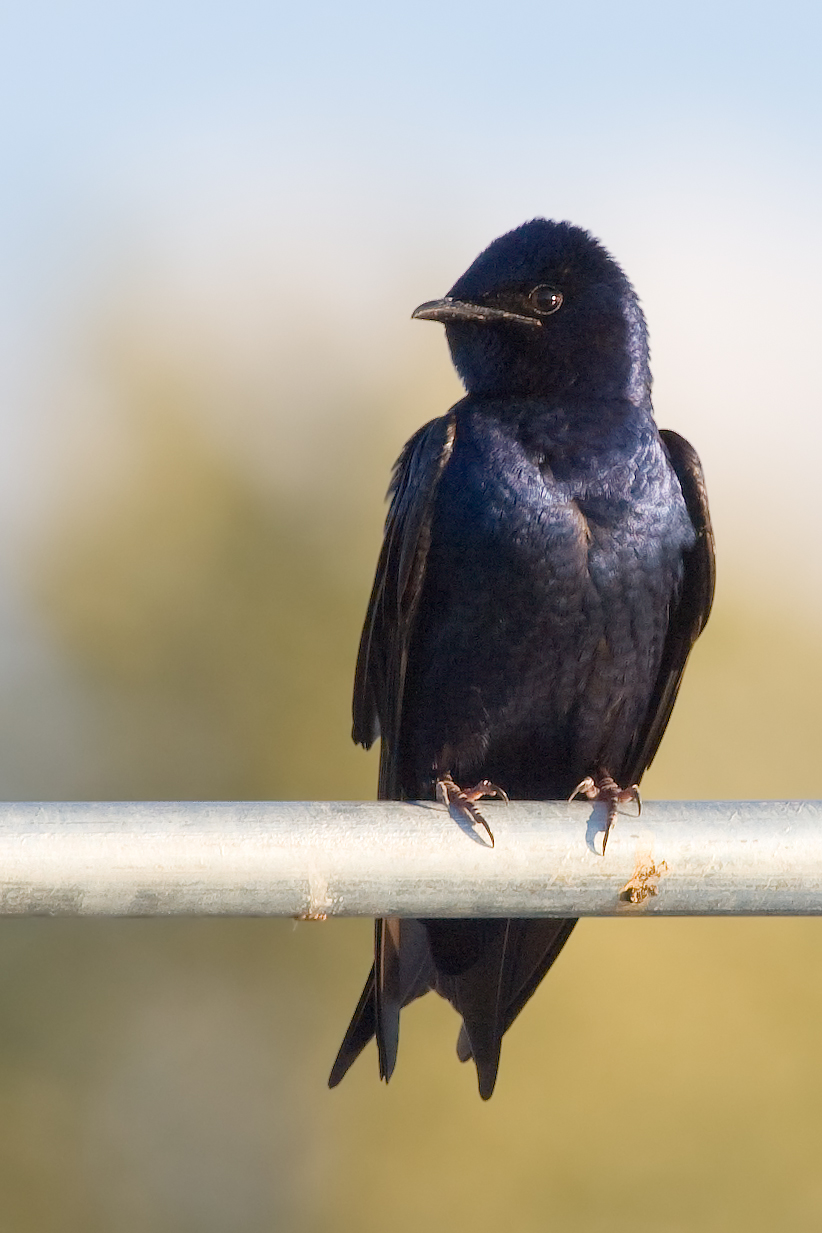
It’s only the males of the species that show blue iridescence as females are gray, blue, and white.
Purple Martins are involved in a migration process that takes them from Central America to North America.
A tendency to be very vocal is specific to these birds. Their sounds can be distinct, especially for males in the breeding season.
These birds are known to be fast fliers and are found in 3 subspecies according to their range from Southern Canada to The US, and Mexico.
Distribution – Canada, Eastern US, Mexico
2. Costa’s Hummingbird
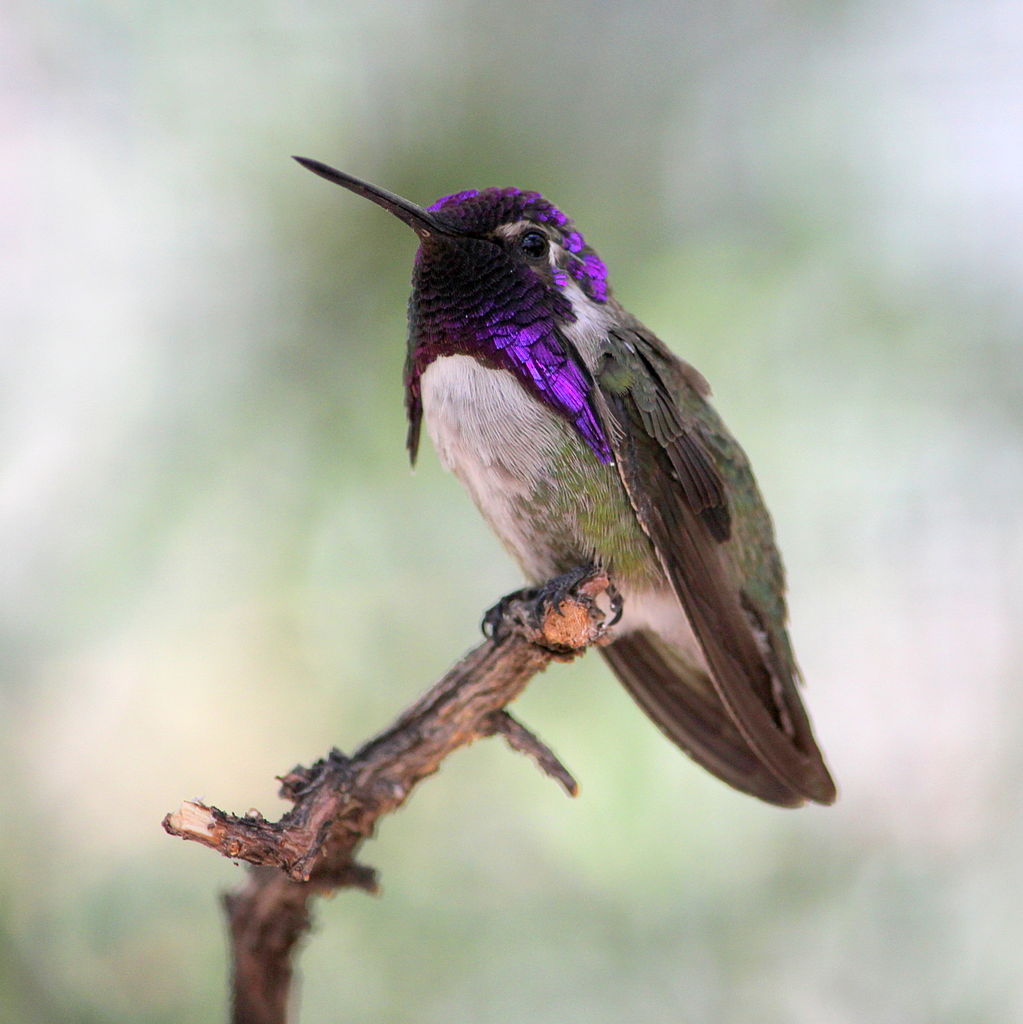
The deep purple coloring is specific to Costa’s Hummingbird (Calypte costae). This is a species with considerable coloring differences between males and females.
Male Costas’ Hummingbirds have a purple cap, which means their head and neck are purple. They also exhibit a large purple area on the upper chest.
Green and yellow colors are specific to the rest of its body, together with one small blue patch at the back of its head.
Females are dull-colored and lack blue or purple patches.
This species has a very specific habitat in North America around California and further South in Baja California.
It can be seen in desert areas and it may move along nearby municipalities at times.
Distribution – California, New Mexico, Baja California
3. Varied Bunting

Growing up to a size of just over 5 inches, The Varied Bunting (Passerina versicolor) is a colorful bird that adapts its colors to the breeding season.
Males of the species shows a more contrasting color change into the breeding season when their head becomes purple and red.
Outside of this season, the coloring of the male’s head is purple and brown.
Additional purple sections are also seen on the upper chest and the back, only contrasted by the blue wing.
This species is seen around rivers and lakes where it chooses trees and bushes to nest in. Its females build nests to lay their eggs in.
Varied Bunting eggs are also colorful, being mostly blue.
Distribution – Arizona, New Mexico, Texas, Mexico
4. Western Swamphen

Dark purple is seen on the plumage of Western Swamphen (Porphyrio porphyrio). These large birds are found around swamps and water and are identified by their loud sound which doesn’t resemble bird calls.
A red beak and blue lateral patches on the head are further specific to The Western Swamphen.
Fish-based diets are characteristic of these birds as they spend a lot of time around swamps and lakes.
Western Swamphen is further known for their collaborative ways of life as they live in pairs but mostly in small groups.
Southwestern and Southern European habitats are areas where the species is well-documented.
Regions of North Africa are also common native areas to these birds but their status is now uncertain in these territories South of The Mediterranean.
Distribution – Spain, Italy, Tunisia
5. Purple Finch

A red-to-purple head is specific to the male Purple Finch (Haemorhous purpureus). This species has a purple head and a purple neck plus purple sections on its chest.
Brown and white colors dominate the appearance of the female Purple Finch.
Some of the best areas for these birds include North American woodlands, where they even breed.
These are areas with mixed trees or coniferous trees as the species can live at higher altitudes.
Much of its range is also similar to the range of The Common House Finch as these birds even compete for food.
Various seeds and insects are eaten by these birds.
Furthermore, they can also eat different types of forest fruits in cold weather.
Some Purple Finches live sedentary lives while others migrate. Canadian populations sometimes travel South to overwinter in California.
Distribution – Eastern United States, Southern Canada, California, Mexico
6. Shiny Cowbird

Black-purple nuances are specific to the dark Shiny Cowbird (Molothrus bonariensis). Its purple nuance can sometimes have blue undertones and may be spotted along its wings.
The female of the species is known to have pronounced blue nuances as opposed to males.
Shiny Cowbirds are mainly found across South America. Small populations are also noted in Cuba and Southern Florida.
The females of this species show parasitism traits as they rely on other birds to care for their eggs and young.
Female Shiny Cowbirds lay eggs in the nests of other species soon after breeding.
These females may also spread their eggs through numerous other nests to increase the likelihood of success. In most cases, females tend to look out for good nests in cavities.
Distribution – Florida, Cuba, South America
7. Purple Sunbird

Purple Sunbirds (Cinnyris asiaticus) are named after their iridescent appearance. These birds may appear blue but they have deep purple nuances when seen from a close distance.
Direct sunlight impacts how these birds appear. However, it’s only the males that are so brightly colored, mainly to attract females.
Purple Sunbirds tend to live together in small groups.
While large flocks are rare, Purple Sunbirds can still help each other out when their nests are in danger.
These types of birds can mob certain types of predators attacking their nests.
Nests represent a main priority for the females of the species as males take no turns in incubation.
The female of the species is easily distinguishable from the male through its bright appearance. Unlike males, they are mostly olive and yellow.
Woodlands are among the top places where these birds are seen, mainly around Asia.
Distribution – Southeast Asia
8. Purple-crested Turaco

The purple coloring is specific to The Purple-crested Turaco (Tauraco porphyreolophus). This species has a purple head, purple belly, and purple wings.
Its neck and chest are green and dark green.
Also known for their long tails, these types of African birds have crests, green lateral face spots, and large black and red eyes.
The species mainly eat fruits and seeds and it plays an important role in the spread of seeds in its natural habitat.
This is mainly a habitat of woodlands and it holds an important cultural role in many of its habitats.
While not a state bird, Purple-crested Turacos used to be offered as gifs due to their multicolored appearance.
Distribution – Kenya, Malawi, Swaziland, Uganda
9. Purple Grenadier
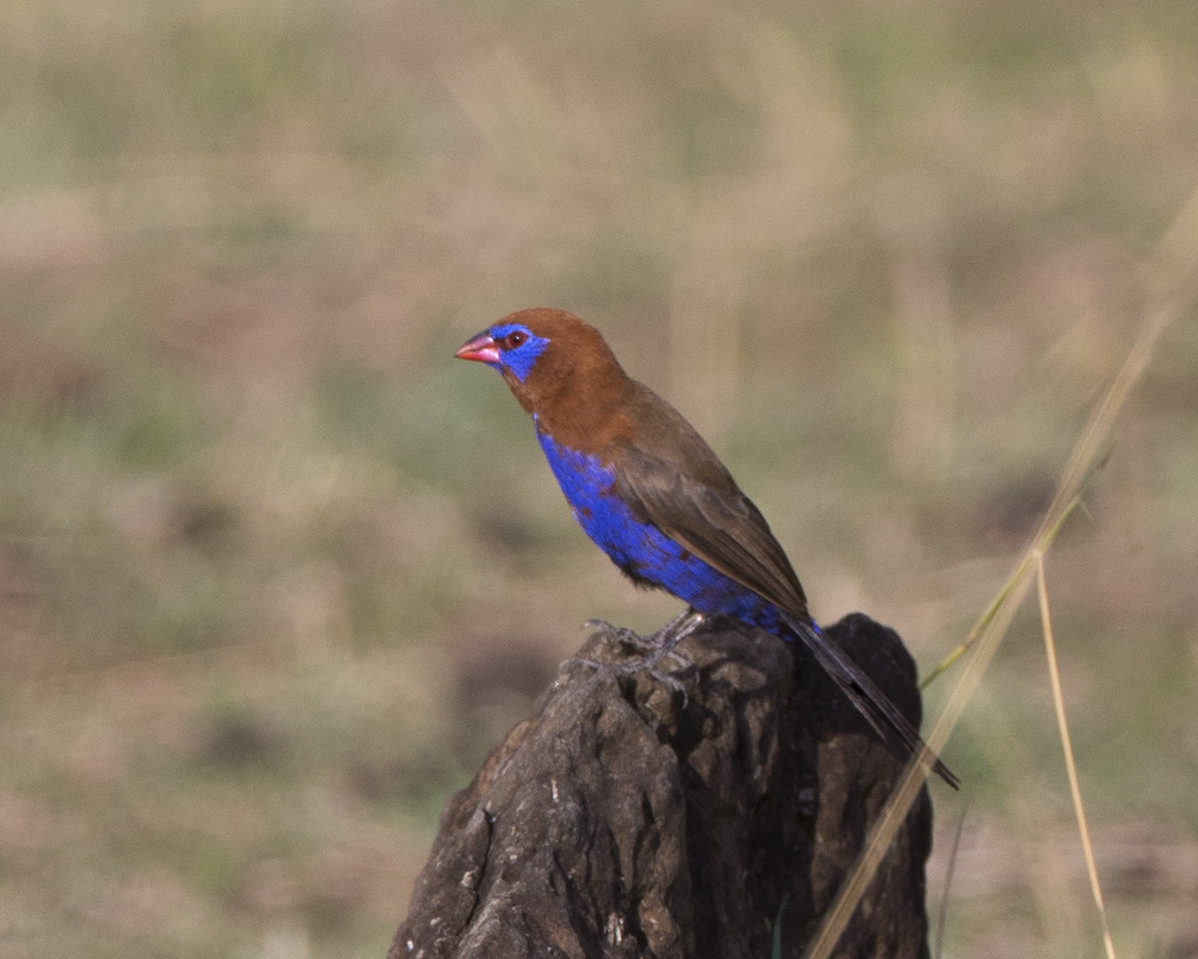
Male Purple Grenadiers (Granatina ianthinogaster) are more colorful than females. They show a combination of dark red and dark purple colors.
Their heads and necks are mostly dark red. There’s a blue-purple mask around its eyes as well.
The lower belly and the wings of the species show purple and dark purple coloring.
Females of the species are darker but still have a blue face mask similar to males.
The female Purple Grenadier has yellow-brown bellies with dark gray wings. Both male and female Purple Grenadier have red beaks.
As Purple-crested Turacos, Purple Grenadiers are also African natives.
This species can also be identified by its high-pitched sounds.
Distribution – Ethiopia, Somalia, Uganda
10. Purple-throated Woodstar

A bright purple color is specific to the male Purple-throated Woodstar (Philodice mitchellii). This species has a bright white belly and a dark appearance with a long black beak.
Females have bright brown bellies and gray-brown heads. A white chest is specific to this species.
This species is a short-distance migrator. It moves up in elevation outside of the breeding season.
Starting with December, these birds lower their elevation for the breeding season which lasts a few months.
The range of the species is mostly tied to Northeastern South American woodlands.
It’s here that the birds have a warm humid climate and plenty of trees and shrubs to collect the nectar from.
These types of birds also feed on insects and spiders.
Distribution – Colombia, Ecuador
11. Purple-backed Fairywren

A blue purple head with a black face and neck is seen on the male Purple-backed bird (Malurus assimilis) which also has a vivid purple back.
The purple nuance on its back is brighter than the blue-purple nuance on its head. This species has a black beak and a black neck while its wings are brown at the base and white at the tips.
The long tail of The Purple-backed Fairywren is black and white.
An Australian native, this species is active throughout the year. They are mostly seen in Australia’s scrubland where they breed and build nests.
Distribution – Australia
12. Purple Gallinule

One of the common types of birds that live on water and around marshes includes The Purple Gallinule (Porphyrio martinica).
These large birds have blue-purple heads, necks, and bellies. A bright blue spot is seen on the front part of their heads.
Purple Gallinule has a red and yellow beak with green wings. These birds have strong yellow legs adapted to walking on water vegetation.
These adaptations even allow the bird to safely walk along different types of aquatic plants.
A common sight in Florida, this species is present around The Gulf of Mexico, in South America, and as far as Western Europe.
They represent a common sight in shallow water where the females may even be seen building nests directly on the water.
Distribution – Florida, Texas, Mexico, South America
13. Purple Honeycreeper
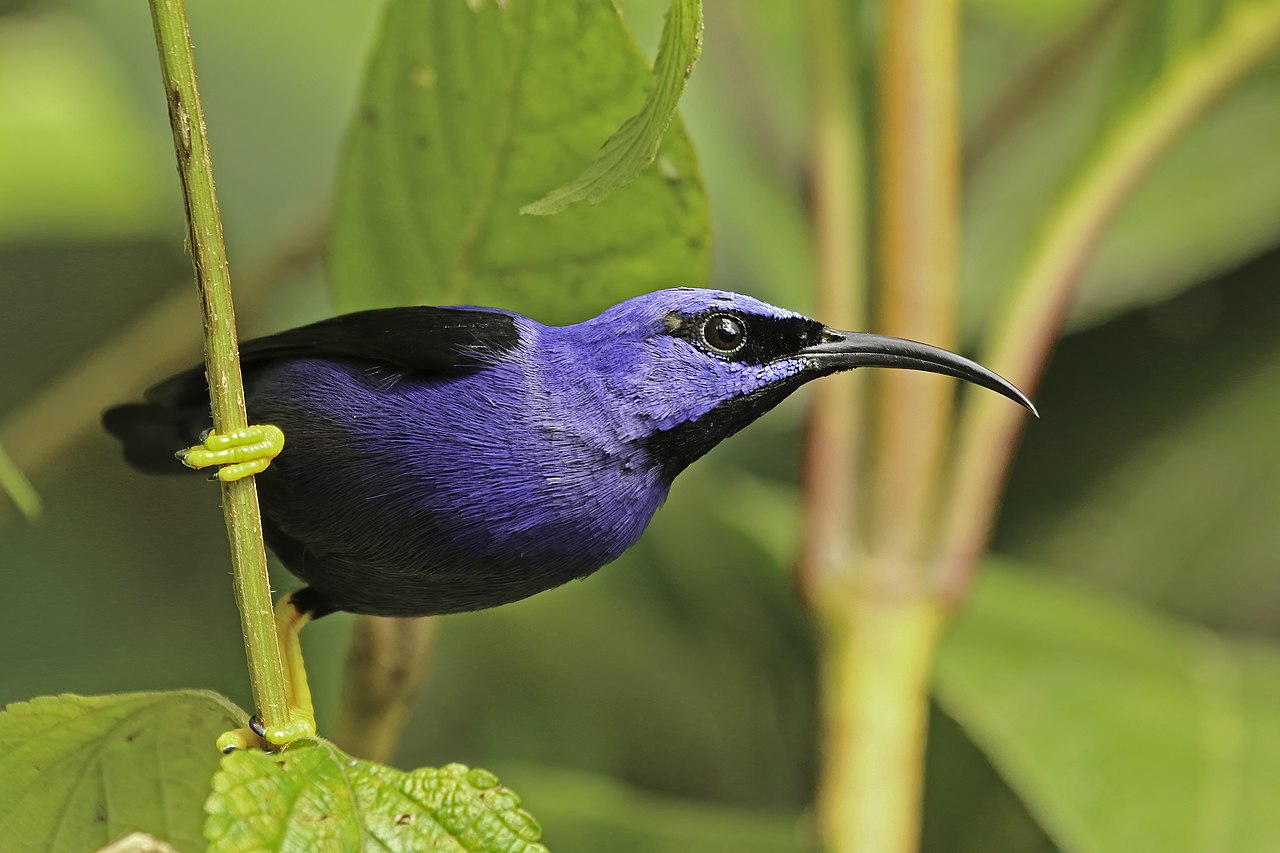
Growing to a size of up to 5 inches, Purple Honeycreepers (Cyanerpes caeruleus) are characterized by a blue-purple color in the case of males and a green color in the case of females.
Males have a dark blue to purple color on the head, belly, and back. The regions around the eyes are black, as are its wings.
The female is mostly green with yellow vertical stripes and a green head.
A common species in citrus plantations, The Purple Honeycreeper is mostly arboreal during the day.
It has a widespread diet, feeding plant nectar as well as on seeds or insects.
Birds of the species live in small groups and prefer to mob any type of predator approaching their nests.
Distribution – South America
14. Velvet-purple Coronet

A species with multiple colors including dark purple, Velvet-purple Cornote (Boissonneaua jardini) shows a high resemblance between males and females.
This is a species that has a base dark purple belly and upper body. Birds of this species have a black head and a black beak.
Their wings are mostly bright purple towards the tips, metallic green at the base, and slightly brown on the edges.
A brown nuance is also characteristic of the underside of its wings.
This species also shows purple iridescence on its back and head in direct sunlight. Blue and dark purple nuances might appear different on its back and head depending on light availability.
Feeding on nectar, this species is found along South American woodlands.
Distribution – Ecuador and Colombia
15. Purple-throated Carib

Both male and female Purple-throated Caribs (Eulampis jugularis) have a similar purple color but they differ in size and beak shape.
Males are slightly larger and heavier while females have a rounded beak compared to the straighter beak of the male.
This species has dark purple plumage on the body and the belly with bright purple plumage on the head.
There’s a metallic green hue on it’s the base of its purple wings as well.
Purple-throated Carib’s aren’t found on the continental North American territory. Most of these birds live in small populations in Antigua, Barbados, or Saint Vincent.
While these are islands with warm weather, these birds only breed in the first part of the year here.
Distribution – Antigua, Barbados, Saint Vincent, St. Lucia
16. Purple-breasted Cotinga
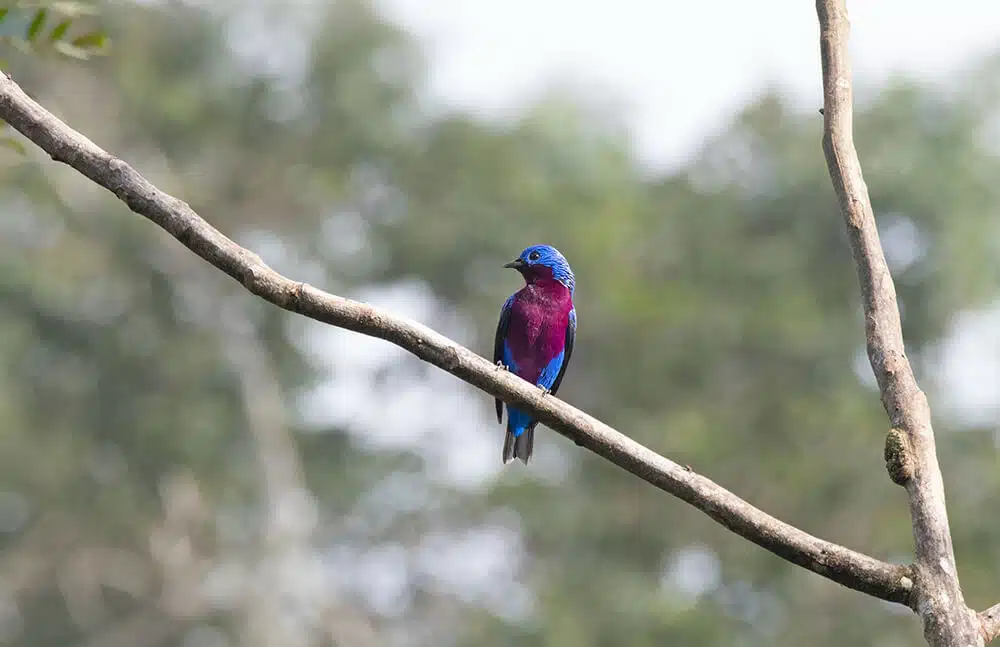
A South American native, Purple-breasted Cotingas (Cotinga Cotinga) are among the colorful birds of the continent in the case of males and juveniles.
The male bird features a bright purple chest and upper belly coloring. Its lower belly and body are mostly blue, as is its head. Its wings are mostly dark purple to black.,
Females have white and brown coloring without any purple or blue nuances.
Juveniles of the species are dominated by an azure blue nuance on the body and the head.
These types of birds live in forests where they can fruit to feed on. Most of their days are spent up on trees in remote areas away from urban areas.
The species inhabit woodlands in Northern and Central South America and can be heard with its whistle-like call.
Distribution – Venezuela, Colombia, Ecuador, Guyana, Suriname, Brazil
17. Violet-backed Starling

A species adapted to elevations of almost 7.000 feet, Violet-backed Starlings (Cinnyricinclus leucogaster) stand out with their bright violet-purple back and head.
This is a species with a different coloring between males and females which means the male is the one with the brighter appearance, as with most types of multicolored birds.
Males have contrasting white bellies and gray legs.
The females of the species have brown, white, and tan coloring, being harder to identify.
Commonly found around woodlands, this species prefers wide open areas across vegetated habitats.
It’s in open areas that this species can locate different types of food, mainly among fruits and seeds.
On occasion, this species may also feed on local spider species, especially those found up above in trees rather than those on the ground.
Distribution – Sub-Saharan Africa
18. Violet Sabrewing

Violet Sabrewing (Campylopterus hemileucurus) is a species commonly found in Central America with some coloring differences between its regions.
Males of the species can be dominated by purple body color. Purple plumage covers their back, head, and belly. Blue and green metallic wings are further specific to this species.
These birds may also be dominated by black and blue colors outside of the breeding season.
A bright green color dominates the appearance of the female.
Violet Sabrewings are known to migrate, but only on short distances.
These nectar-feeding birds fly to high elevations for the breeding season and return to various plantations afterward.
Wilf plantain and banana trees are among the most common nectar sources for these birds.
While some of these have expanded to Florida, the bird is only found in Central America.
Distribution – Mexico, Guatemala, Panama, Honduras
19. Violet-crowned Woodnymph

Various shades of purple and green are specific to the male Violet-crowned Woodnymph (Thalurania colombica).
Its head is multicolored, mostly purple and blue or violet and purple-blue.
The chest of the male has a metallic green color while its belly is mostly purple. A metallic purple appearance is also specific to its wings.
This species further exhibits a long dark and curved beak.
Females lack both the violet and the purple nuances of the male. They have a grey belly and a green head. Females also show metallic green wings.
A native South American, this bird represents a species that feeds on plant nectar and it chooses short trees and shrubs for food and shelter.
These birds like nectar so much that they become aggressive around trees and shrubs they find to have plenty of nectar.
Distribution – Panama, Columbia, Ecuador, Honduras, Peru
20. Violet-bellied Hummingbird
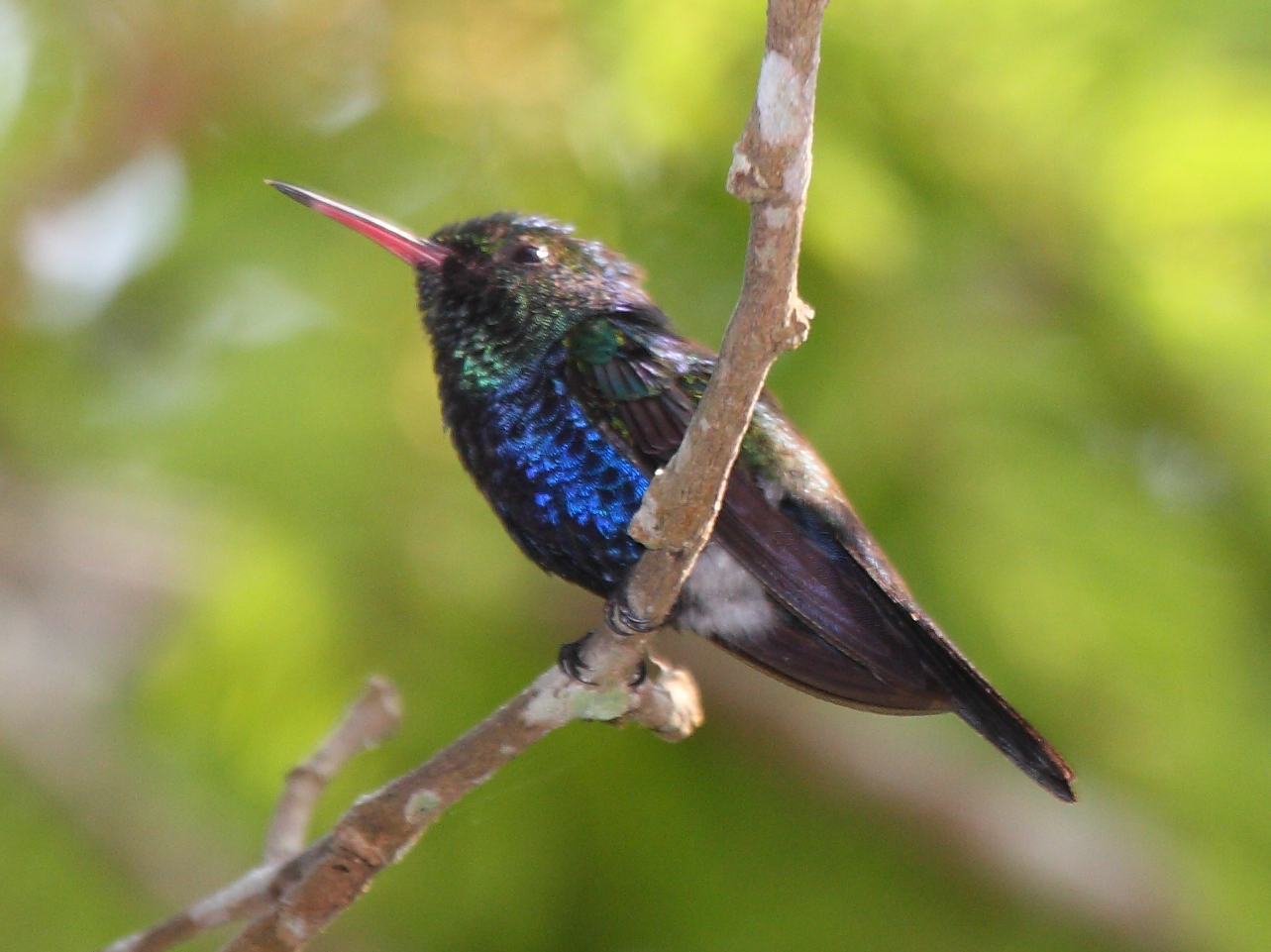
Violet and purple shades are highly characteristic of The Violet-bellied Hummingbird (Chlorestes julie).
This bird has a combination of dark violet-blue colors on the belly with purple shades on the wings.
The tip of its tail is also purple while its head and outer wings show a contrasting green and blue color.
Some males even have a completely purple belly and chest and a uniform green cap head color.
As in other species, females and males have different coloring. This is why the female Violet-bellied Hummingbird has a white-to-gray belly and a green head and body with gray wings.
This species lives along woodlands and feeds on shrubs and flowers.
Birds of the species make a long 2-3 seconds triiil-triiil sound and they can further be differentiated by sizing as males are larger. The species is native to Southern Central American and Northern South America.
Distribution – Panama, Columbia, Ecuador
21. Purplish Jay

Subtropical and tropical woodlands are the home to a few purple birds, including Purplish Jays (Cyanocorax cyanomelas).
This species has a dark purple color and may even appear dark gray or charcoal when seen from a long distance.
A combination of purple and gray colors gives the birds its dark appearance. Its lower body and wings are more likely to show purple colors while its head and neck are more likely to be dominated by gray colors.
The underside of the bird is also purple-gray while its legs are dark gray to black.
Much of its range is specific to the tropical and subtropical woodlands in the Central and Western parts of South America.
These birds are also found in old woodlands where trees have already died and where other types of vegetation are taking over.
Distribution – Bolivia, Brazil, Paraguay, Argentina
22. Purple-breasted Sunbird
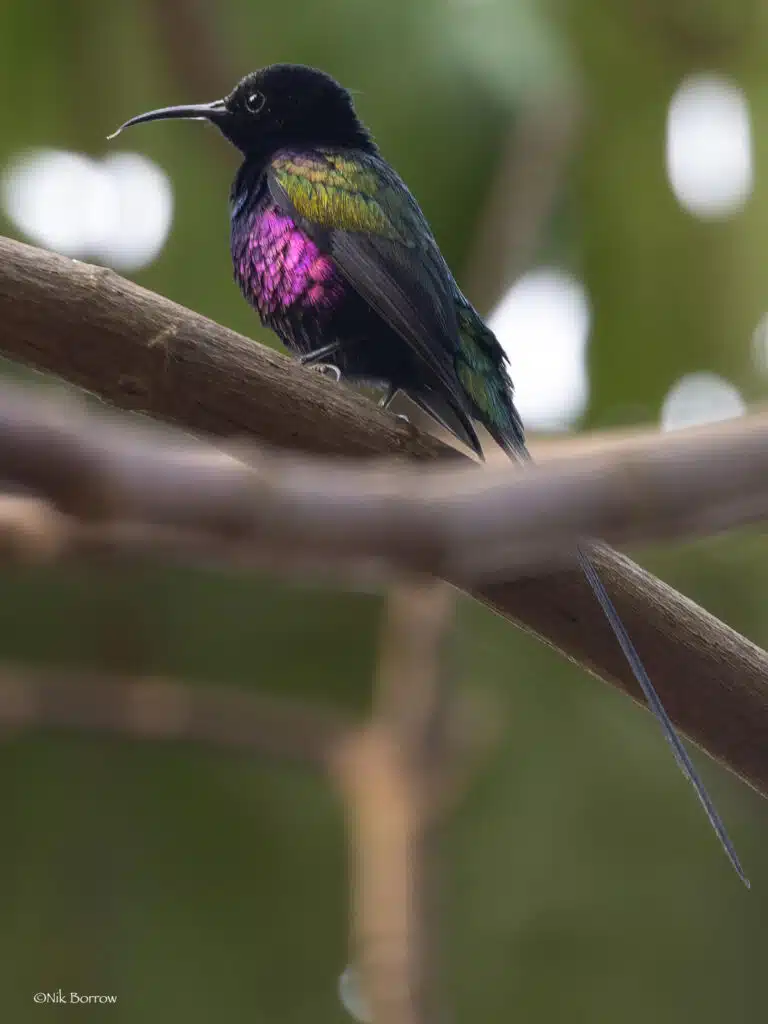
An African native, The Purple-breasted Sunbird (Nectarinia purpureiventris) is a species with yellow, purple, blue, pink, and black colors.
Most of its purple sections are seen along its chest and belly. Purple sections are also characteristic of the base of its wings while the rest of its wings are yellow and green.
The head of the bird has a contrasting black appearance.
Active throughout the year, this species has brighter females, dominated by white, yellow, and pale green.
While there are considerable coloring differences between males and females, the male Purple-breasted Sunbird is only purple during the breeding season.
Mostly feeding on nectar, these birds are mostly seen along Africa’s Lake Edward and Lake Kivu.
They are also found along forests in multiple Central African countries.
Distribution – Uganda, Rwanda, Burundi, Congo
23. Western Violet-backed Sunbird
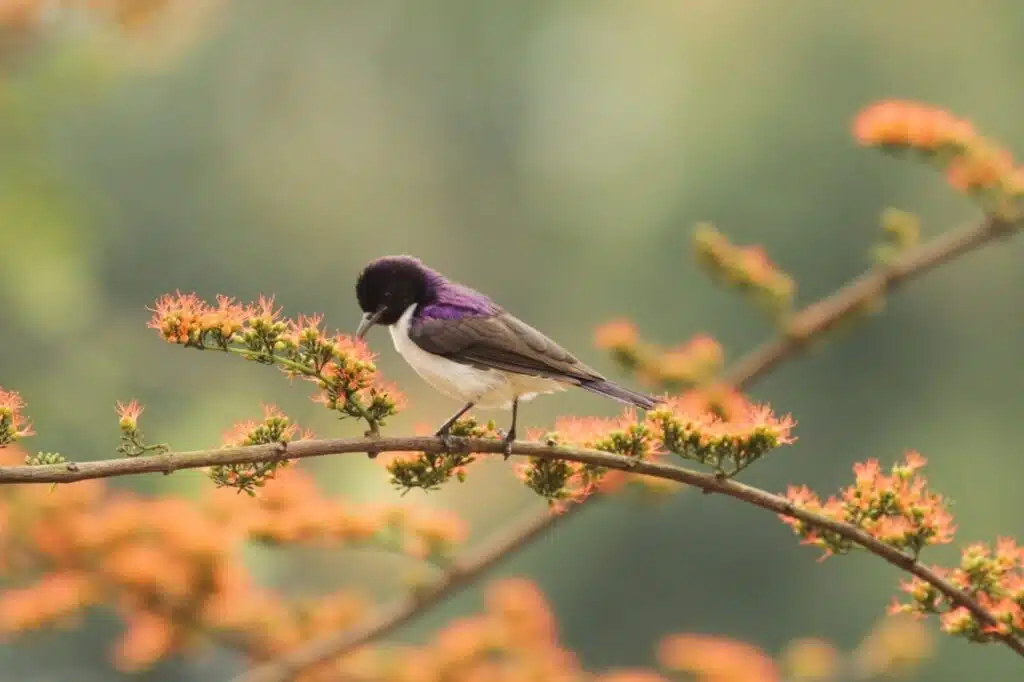
Moist woodlands in sub-Saharan Africa are among the ideal habitats of The Western Violet-backed Sunbird (Anthreptes longuemarei).
This species shows small coloring differences between males and females.
One of the main differences between the species is the purple section along the wings and body which is only seen in the male bird.
Smaller purple sections are seen on the head and face of the bird species.
Females have white and yellow bellies with gray and brown heads and wings.
During the breeding season, males show purple and even blue spots along the base of the wings.
Western Violet-backed Sunbirds are also singing birds. They have different vocalizations which range from short to long sounds.
Distribution – Guinea, Burkina Faso, Nigeria, Gabon, Angola, Tanzania, Mozambique, Kenya, Central African Republic, Zambia, Zimbabwe
24. Purple-crowned Fairywren

An Australian native, Purple-crowned Fairywren (Malurus coronatus) are birds with purple-colored heads. The crown or the top of the head of male birds is purple.
These birds have bright bodies and also stand out with their elongated bright blue tails.
Female Purple-crowned Fairywren has a dark gray head with a similar bright body and a similar long blue tail as males.
Males of the species show monogamous traits while females don’t.
These birds generally live solitary lives except for the breeding period, a time when males also show their purple crowns.
Birds of the species have a low-pitched vocalization and can be spotted during the breeding period in small groups.
Purple-crowned Fairywren is found in areas with vegetation along various water sources.
Distribution – Northern Australia
25. Fork-tailed Woodnymph

Male Fork-tailed Woodnymphs (Thalurania furcata) have purple bellies and lower chests while females exhibit violet-blue wings.
The neck of the male is also bright, having a metallic green hue.
Living in The Amazon Basin, this bird is tied to woodlands where it spends most of its life.
Females of the species are more aggressive than males, especially to other birds when it comes to food sources.
The Fork-tailed Woodnymph is a species that feeds on nectar from plants it visits on rotation. Females are aggressive to other birds visiting plants in their rotation.
Dependent on nectar, The Fork-tailed Woodpnymphs are believed to travel from one location to another following plant flowering periods.
Distribution – Amazon Basin, Brazil, Bolivia, Uruguay
26. Wompoo Fruit Dove

Doves of the species (Ptilinopus magnificus) have dark purple chests and bellies, a color seen both in males and females.
A green and yellow contrasting color combination is mostly specific to Wompoo Fruit Doves.
Birds of the species have bright green wings with dark green tails. Yellow spots are also seen across the wings.
The head of the species has an azure color while the beak is red with a yellow tip.
Birds of the species are rare outside Australia as they mostly live in the rainforests of the continent and New Guinea.
A fruit-eating species, this type of dove is present in high numbers across its native areas and rainforests.
As its name implies, this bird likes to eat fruit. Figs are believed to be its main food source, together with cinnamon fruits.
Distribution – Eastern and Northeastern Australia, New Guinea
27. Great-tailed Grackle

A dark purple neck is specific to The Great-tailed Grackle (Quiscalus mexicanus). Dark blue colors are seen on the wings and the long tail of the species.
The female has gray and brown colors, lacking the purple nuances seen in males.
Birds of the species originate in the tropical forests of South America. They have been introduced to Central and North America.
The range of the species varies but it now includes Southern US states as their Northern limit across The Americas.
Much of their high population areas are distributed across Mexico and Panama.
This is where it is even generally referred to as a species of crow in Central America.
Distribution – Southern US, Mexico, Honduras, Guatemala, Panama, Ecuador, Colombia
28. Violet-green Swallow
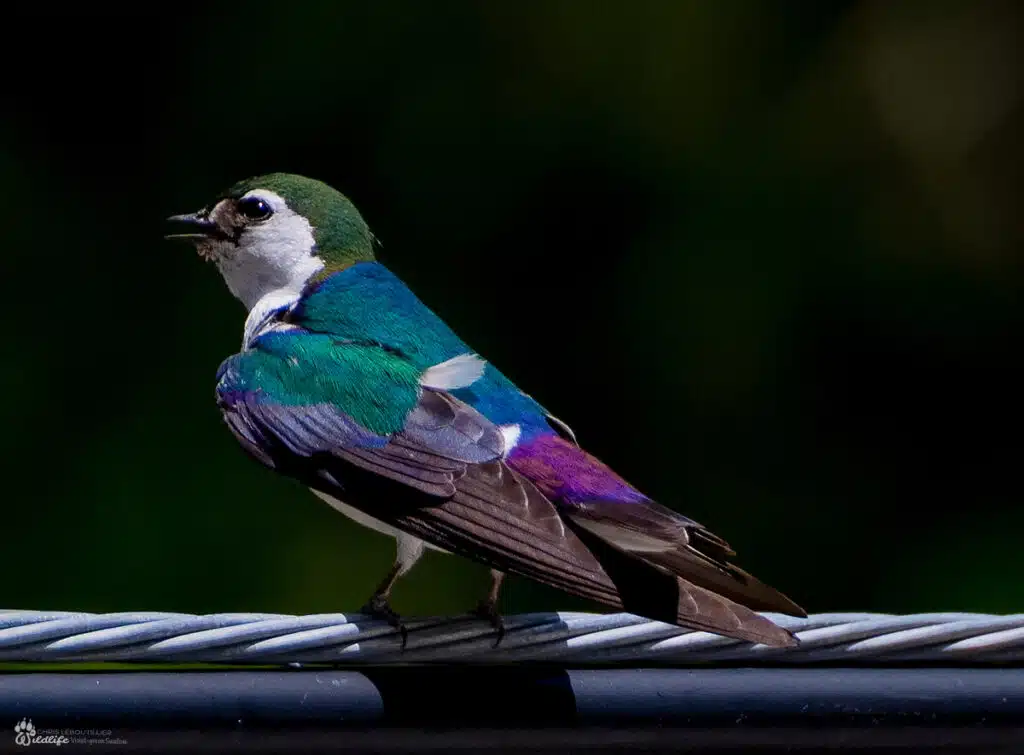
Woodlands across The Americas are the home to The Violet-green Swallow (Tachycineta thalassina).
This is a species dominated by a green-and-white color combination. Purple tails are further characteristic of the birds.
A widespread habitat in the Western parts of North America is specific to the species, even if the birds are also beginning to be seen in the Eastern parts of the continent as well.
Violet-green swallows are known to eat different types of insects. As true insectivores, these birds build their nests in cavities.
They use the cavities in trees to build nests. Some Violet-green Swallows may also repurpose the nests of other birds in their range.
Distribution – Western Canada, Western United States, Mexico
29. Lucifer Hummingbird

Male Lucifer Hummingbirds (Calothorax lucifer) are known for their purple throats which they display during the breeding season.
Females have white throats and light brown bellies.
This species has a widespread presence in Central America. Its range expands to the Southern parts of US states such as New Mexico.
Named after the atypical throat color of males, Lucifer Hummingbirds also have atypical breeding routines.
Males initiate the breeding process by visiting the female at the nest. Females may accept or reject to mate with males.
It’s believed the purple color of the male’s neck helps them stand out in front of females.
Distribution – New Mexico, Arizona, Texas, Mexico
30. Amethyst-throated Mountain-Gem
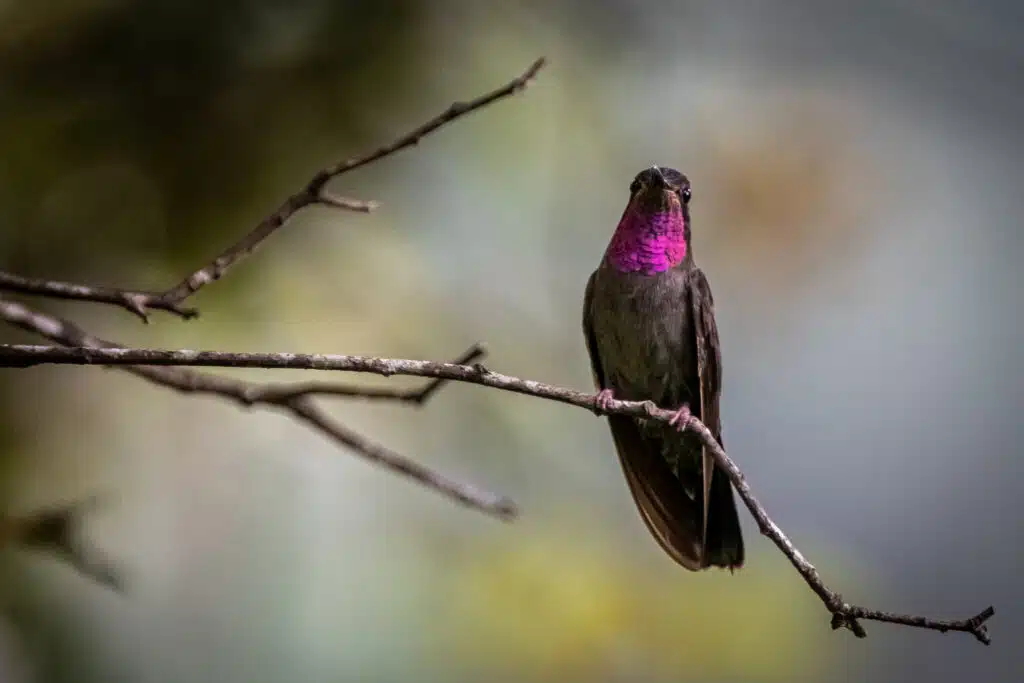
A purple throat is characteristic of The Amethyst-throated Mountain-Gem (Lampornis amethystinus).
Only the male bird features a dark purple neck and dark plumage while the female of the species is mostly gray, green, and brown.
Woodlands are the only habitats of these birds.
They prefer areas with dense canopies where they can live in the shade.
Much of their lives are spent looking for new sources of plant nectar but these birds may also eat different small insects and spiders.
It’s believed Amethyst-throated Mountain-Gem are some of the most complex hummingbirds in terms of vocalizations, with almost 10 different sounds made by the species.
Distribution – Mexico, Guatemala, Honduras
31. Sapphire-spangled Emerald

The breeding period marks the time when the neck of the male Sapphire-spangled Emerald (Chionomesa lactea) turns purple.
A blue neck is specific to the male outside of the breeding season.
Various types of forests including rainforests mark the natural range of these birds.
Sapphire-spangled Emeralds mostly live on the edges of woodlands, including at the edges of rainforests.
The species is confirmed in high numbers on the edges of The Amazon Basin.
All 3 subspecies of The Sapphire-spangled Emerald live around the Amazon Basin.
It’s here the species feeds on the nectar of various wild pea family plants as well as on a wide range of insects.
Distribution – Amazon Basin, Bolivia, Peru, Brazil
32. Amethyst Woodstar

Male Amethyst Woodstarts (Calliphlox amethystina) have an iridescent purple neck.
While similar to males, females have a bright neck and belly with small iridescent green markings along the neck.
These birds grow to a maximum size of 3.4 inches and are found around South America and the Amazon Basin but not in the main center of the rainforest.
It’s believed these birds move with the location of their favorite flowering species for nectar as they can be largely absent in their native range for months at a time.
While small, Amethyst Woodstar birds are also known to create low-pitched short vocalizations.
Unlike other small birds in its area, the species is also found at high altitudes of up to 5.000 feet.
Distribution – Brazil, Peru, Bolivia, Ecuador
33. White-chinned Sapphire
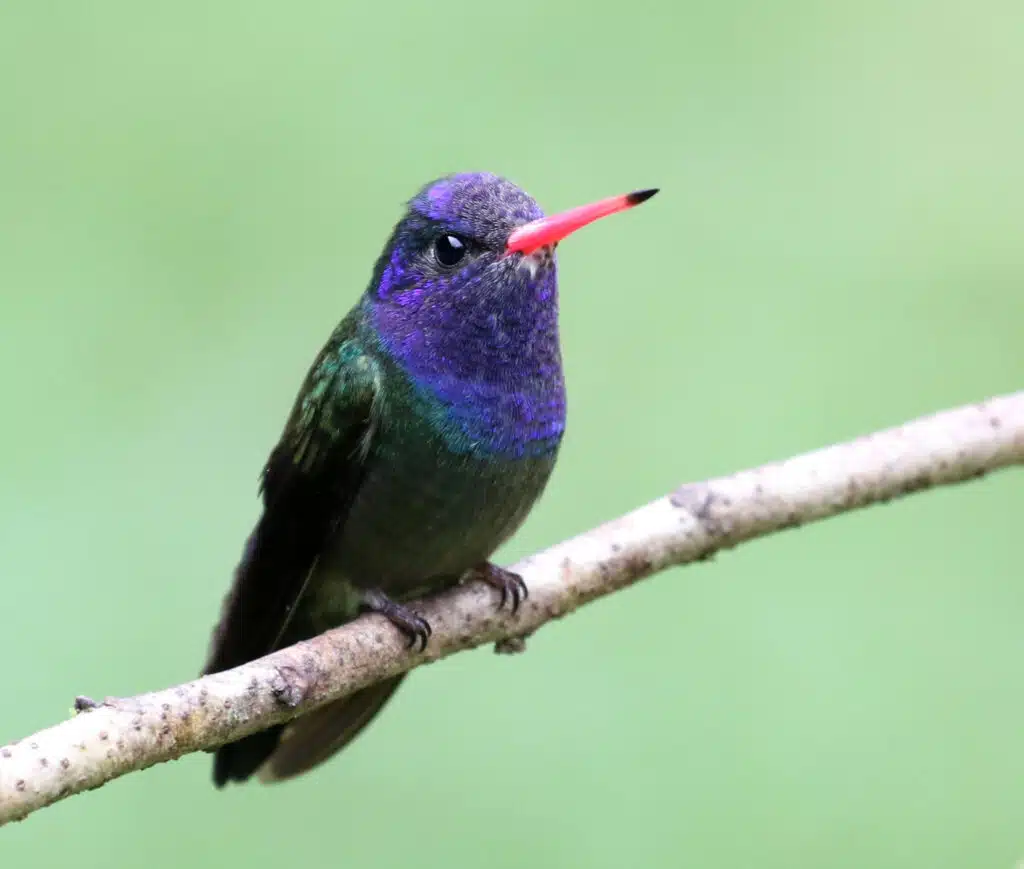
An almost black appearance is characteristic of The White-chinned Sapphire (Chlorestes cyanus). This is a species that has very dark purple coloring, only visible in direct sunlight.
Much of its chest, belly, back, wings, and head are covered in dark purple plumage.
Females have a bright chest and belly but may also show smaller and rare purple plumage areas.
A typical species along the Amazon rainforest, the White-chinned Saphire is only found in South America.
Its exact numbers aren’t known and its populations are believed to be in decline.
Much of these assumptions may be attributed to its movements throughout the year as well.
Distribution – Brazil, Venezuela, Guyana, French Guyana, Suriname
34. Long-tailed Woodnymph

Purple plumage is only characteristic of the male Long-tailed Woodnymph (Thalurania watertonii). Females have gray and brown coloring while males are iridescent green and violet, turning purple in the breeding season.
Unlike other birds with purple plumage in South America and around The Amazon Basin, Long-tailed Woodnymphs are mostly present in coastal areas.
Their habitat is restricted to woodlands around coastal areas but this also means these birds may be spotted next to inhabited areas, unlike many other purple species in the deep Amazon.
These birds build nests from scratch. They lay them on the branches of shrubs of small trees.
Distribution – Northeastern Brazil coastline
35. Mexican Sheartail

Mexican Sheartail birds (Doricha eliza) are found across various habitats in The Yucatan.
These include coastal areas as well as areas with agave. Tropical and subtropical climates are favored by the species.
Found in warm climates of Central America, the species is known to feed on plant nectar and occasionally on insects.
Males have iridescent purple necks while females are white and brown.
Apart from the color differences in the sexes, it’s also believed male Mexican Sheartails are considerably outnumbered by females.
Both males and females share some physical traits such as having an elongated curved black beak, mostly suitable for drinking plant nectar.
Distribution – Mexico, Yucatan Peninsula
36. Slender Sheartail
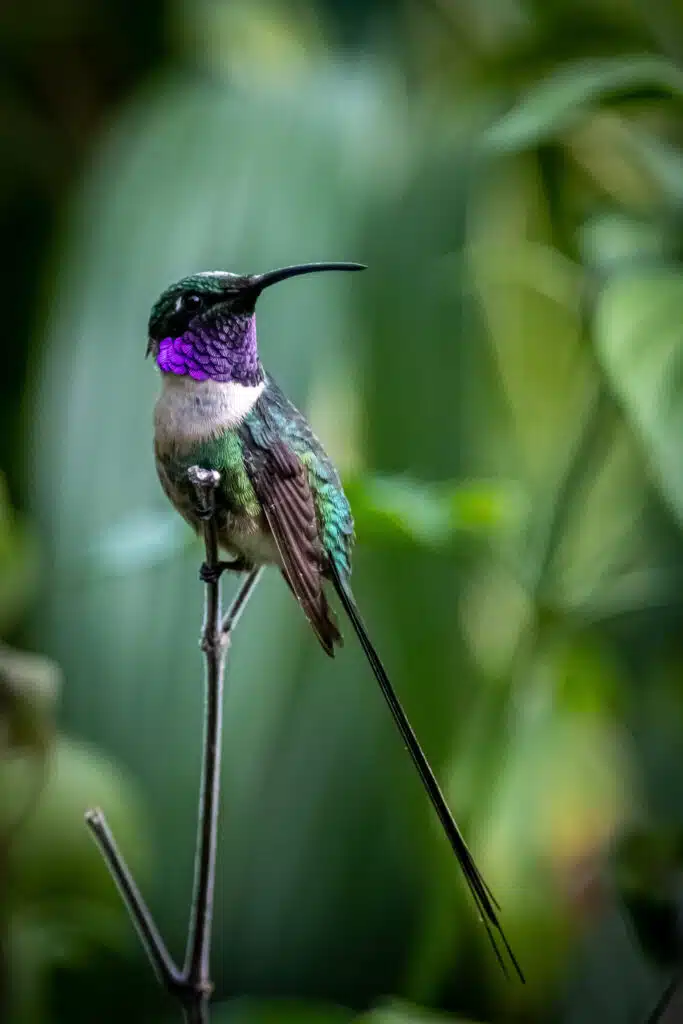
Purple-colored Slender Sheartail (Doricha enicura) males can be spotted in October, the month that marks their peak breeding season.
This species may still not be easy to spot as it lives in remote mountainous areas of Southern Mexico.
It inhabits the mountains of Chiapas state on the Southern side of the country.
Slender Sheartail males have purple necks. They have a green and white belly and a green back.
Females have white and yellow bellies with dark heads. Both males and females have a long and slightly downward-facing beak.
Nectar and spiders are some of the most common foods of these birds.
Distribution – Mexico, Honduras, El Salvador,
37. Red-tailed Comet
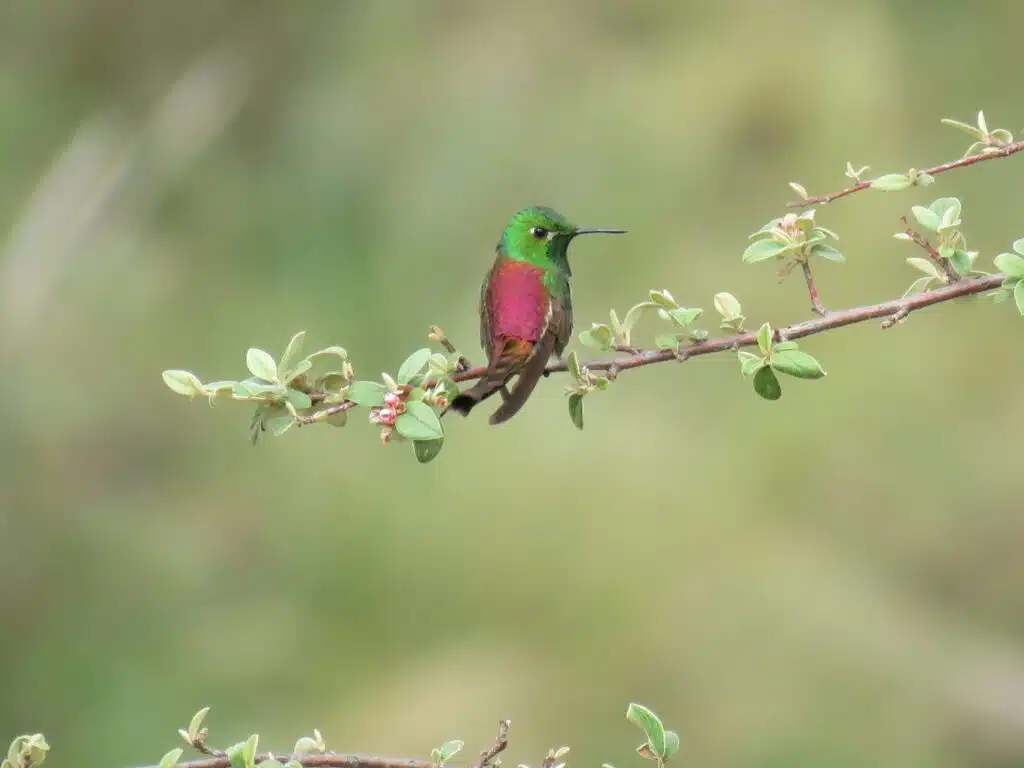
Red-tailed Comets (Sappho sparganurus) are some of the largest hummingbirds as they grow up to 5.9 inches.
Spotted along The Andes, Red-tailed Comet is among the species with purple wings and a metallic green body.
These birds also have long yellow-golden tails.
The female of the species has a similar iridescent green appearance with brown and gray wings.
Feeding by hovering, the small birds have long and adapted beaks to pierce plants and drink nectar.
Deciduous woodlands are the main distribution area of these birds and some of them are even found in inhabited areas.
Distribution – Peru, Chile, Argentina
38. Black-throated Sunbird

Dark red, black, and purple colors are specific to the male Black-throated Sunbird (Aethopyga saturata).
This is a species that has a mostly black appearance from a distance. Males show a purple crown in the breeding season.
Outside of the breeding season, males have a black main color with a blue crown and a long blue and black tail.
The red sections on the upper back of the bird are also brighter red as opposed to dark red in the breeding season.
Females have a bright green color with dark olive-green wings.
Distribution – Vietnam, Thailand, Myanmar, Nepal
39. Gray-headed Swamphen

A purple body and neck are specific to The Gray-headed Swamphen (Porphyrio poliocephalus).
Both male and female populations have a dark purple back of the neck, a purple back, and purple belly coloring.
A light blue nuance is seen on the neck of the bird while its head is gray with red and purple sections and a black and red beak.
An Asian species, the Gray-headed Swamphen has been introduced to Florida.
Its rapid spread and negative impact on local populations have even led to campaigns to have the bird removed from areas such as Florida Everglades.
The species remains abundant despite thousands of Gray-headed Swamphen being removed from the Southern parts of the state.
Distribution – Western Asia, Southern Asia, Florida